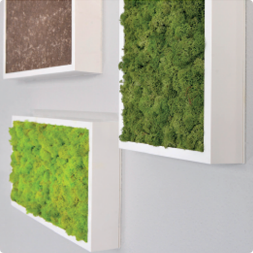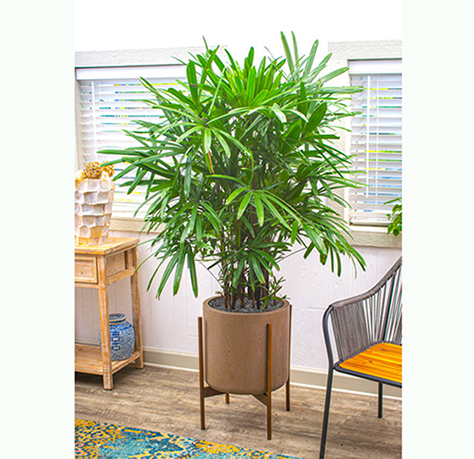Rhapis Palm Care Guide
Looking to add a touch of the tropics to your home? The remarkable Rhapis palm delivers both elegance and beauty to any interior space, instantly delivering a tropical vibe. The Rhapis palm, or Rhapis excelsa, is native to regions of Southeastern Asia and began gaining popularity dating back to the 17th Century- in fact, this palm has been grown as a houseplant in Japan for over 500 years!
Sometimes referred to as the Lady Palm, this versatile palm species is a slow grower that is sure to have you feeling like you’re on vacation for many years to come. This plant’s fan-shaped, glossy green leaves take up significant vertical space while not stretching out too wide, allowing you to home this graceful palm in even the most challenging of spaces. The Rhapis is also much more tolerant of lower light conditions than your average palm, which only adds to the allure of this must-have tropical species.
Here at PLANTZ, we offer both Florida- and Hawaii- grown Rhapis which differ somewhat in their growing capacities. The Florida plants are likely to grow more wide than tall, while the Hawaiian-grown Rhapis pack a lot of height into their growpots and are taller compared to their spread. The Hawaiian Rhapis are also grown in lava-rock based soil, called cinder, like most other plants in our Hawaiian collection. Whichever coast it may come from, the Lady Palm is sure to immediately upscale any interior setting it inhabits.
This plant is certainly picking up popularity in 2021- so pour up your favorite island cocktail and beat interior designers to the trend with everything there is to know about the Rhapis palm.
Watering your Rhapis
Both Florida- and Hawaii-grown Rhapis alike will enjoy being thoroughly watered while maintaining an evenly moist root zone between showers. Rhapis are often quite thirsty palms, especially those potted in lava rock as their soil medium should be checked weekly during the first two months after bringing one home (note – they’re delivered). Once the soil feels dry, give your Rhapis a deep watering around the entire soil surface until the water begins to seep out into the drainage saucer. You can then leave this excess water in the saucer and wait until your Rhapis has soaked it all up before watering again.
When watering your Rhapis you should keep in mind that a plant’s root systems are often at the bottom of the grow pot- so even if the top of the soil feels dry, the root zone may still be nice and moist. To ensure your green friend always has the right amount of H2o and is ready for its next drink, we highly recommend a probe such as our very own Soil Sleuth. A soil probe is the perfect addition to your plant-care toolbox and takes all the mystery out of your plant’s watering needs.
Finding the Perfect Lighting for your Lady Palm
As we mentioned before, the Rhapis is fairly adaptable when it comes to lighting conditions. It’s actually one of the most low-light tolerant palms, making it a perfect addition to spruce up an office or hallway. While this species of palm can survive in poorly lit spaces, it takes higher light to get it to thrive.
On the other hand, your Rhapis will grow to its fullest potential and truly thrive for years if placed in moderate, filtered natural light. This sort of lighting is best absorbed from East- or West-facing windows where your plants will have periods of semi-bright and filtered light throughout the day. Aim to give this palm as much sunlight as possible without placing it directly in the sun, as direct sunlight can lead to your elegant palm’s leaves becoming burnt and turning yellow.
When placing your palm in any high-light environment, remember that it will require more frequent waterings than it would if it was in the shade. Be sure to give your Lady Palm a little more love, affection, and water when placing it in a brighter spot, and watch in awe as it flourishes from soaking in all those extra sunbeams!
Pruning: Potential Projects for you and your Palm
Along with the proper watering and lighting conditions, your Rhapis palm will require a little maintenance and grooming to keep them happy and healthy.
To keep your Rhapis glowing and easy on the eyes, give it an occasional wipe down with a damp cloth and get rid of any dust on its graceful leaves. A regular cleaning regimen with a solution of water and light soap will have your Lady Palm feeling as majestic as she looks! With a palm of this magnitude, you may also be able to use a feather duster to gently dust away any impurities on your Rhapis- always make sure the feather duster is clean though, as it’s a primary way to transfer one plant’s pest infestation to another!
Brown leaf tipping is another obstacle you may encounter with your Rhapis- this is natural for old fronds to yellow and become brown.
If an entire frond becomes discolored or dies, it may be necessary to whip out the pruning shears and remove some of your Lady Palm’s dead leaves. Focus on trimming the lower leaves of your Rhapis as new growth typically comes from the center of the trunk, and prune off the leaves as close to the stem as possible. If snipping away at your beloved plants sounds intimidating, head over and check out our Plantz guide to proper houseplant pruning to soothe all of your worries!
The Lady Palm may be pretty easy-going as far as tropical plants go, but they do still require some love and attention to really thrive and be their best selves. Give your Rhapis plenty of consistent care by following these helpful tips, and enjoy the endless island atmosphere that this elegant palm will provide for your home!



















